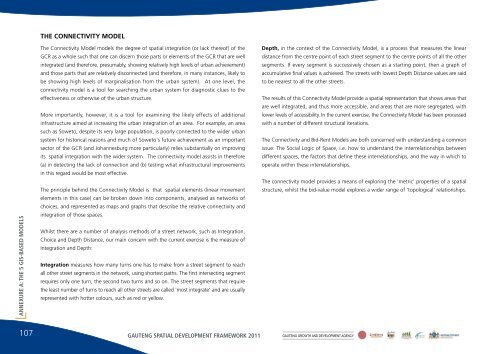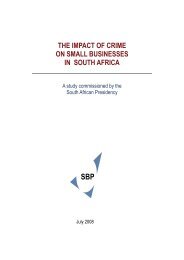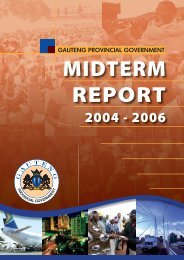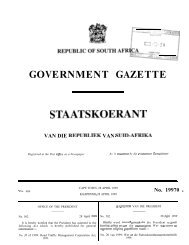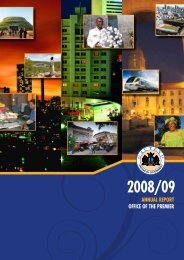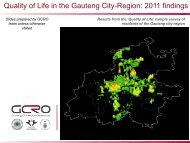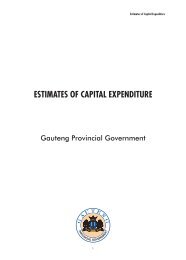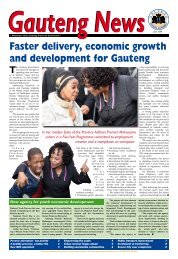the gauteng spatial development framework - Gauteng Online
the gauteng spatial development framework - Gauteng Online
the gauteng spatial development framework - Gauteng Online
Create successful ePaper yourself
Turn your PDF publications into a flip-book with our unique Google optimized e-Paper software.
THE CONNECTIVITY MODELANNEXURE A: THE 5 GIS-BASED MODELSThe Connectivity Model models <strong>the</strong> degree of <strong>spatial</strong> integration (or lack <strong>the</strong>reof) of <strong>the</strong>GCR as a whole such that one can discern those parts or elements of <strong>the</strong> GCR that are wellintegrated (and <strong>the</strong>refore, presumably, showing relatively high levels of urban achievement)and those parts that are relatively disconnected (and <strong>the</strong>refore, in many instances, likely tobe showing high levels of marginalisation from <strong>the</strong> urban system). At one level, <strong>the</strong>connectivity model is a tool for searching <strong>the</strong> urban system for diagnostic clues to <strong>the</strong>effectiveness or o<strong>the</strong>rwise of <strong>the</strong> urban structure.More importantly, however, it is a tool for examining <strong>the</strong> likely effects of additionalinfrastructure aimed at increasing <strong>the</strong> urban integration of an area. For example, an areasuch as Soweto, despite its very large population, is poorly connected to <strong>the</strong> wider urbansystem for historical reasons and much of Soweto's future achievement as an importantsector of <strong>the</strong> GCR (and Johannesburg more particularly) relies substantially on improvingits <strong>spatial</strong> integration with <strong>the</strong> wider system. The connectivity model assists in <strong>the</strong>refore(a) in detecting <strong>the</strong> lack of connection and (b) testing what infrastructural improvementsin this regard would be most effective.The principle behind <strong>the</strong> Connectivity Model is that <strong>spatial</strong> elements (linear movementelements in this case) can be broken down into components, analysed as networks ofchoices, and represented as maps and graphs that describe <strong>the</strong> relative connectivity andintegration of those spaces.Whilst <strong>the</strong>re are a number of analysis methods of a street network, such as Integration,Choice and Depth Distance, our main concern with <strong>the</strong> current exercise is <strong>the</strong> measure ofIntegration and Depth:Integration measures how many turns one has to make from a street segment to reachall o<strong>the</strong>r street segments in <strong>the</strong> network, using shortest paths. The first intersecting segmentrequires only one turn, <strong>the</strong> second two turns and so on. The street segments that require<strong>the</strong> least number of turns to reach all o<strong>the</strong>r streets are called 'most integrate' and are usuallyrepresented with hotter colours, such as red or yellow.Depth, in <strong>the</strong> context of <strong>the</strong> Connectivity Model, is a process that measures <strong>the</strong> lineardistance from <strong>the</strong> centre point of each street segment to <strong>the</strong> centre points of all <strong>the</strong> o<strong>the</strong>rsegments. If every segment is successively chosen as a starting point, <strong>the</strong>n a graph ofaccumulative final values is achieved. The streets with lowest Depth Distance values are saidto be nearest to all <strong>the</strong> o<strong>the</strong>r streets.The results of this Connectivity Model provide a <strong>spatial</strong> representation that shows areas thatare well integrated, and thus more accessible, and areas that are more segregated, withlower levels of accessibility. In <strong>the</strong> current exercise, <strong>the</strong> Connectivity Model has been processedwith a number of different structural iterations.The Connectivity and Bid-Rent Models are both concerned with understanding a commonissue: The Social Logic of Space, i.e. how to understand <strong>the</strong> interrelationships betweendifferent spaces, <strong>the</strong> factors that define <strong>the</strong>se interrelationships, and <strong>the</strong> way in which tooperate within <strong>the</strong>se interrelationships.The connectivity model provides a means of exploring <strong>the</strong> 'metric' properties of a <strong>spatial</strong>structure, whilst <strong>the</strong> bid-value model explores a wider range of 'topological' relationships.107 GAUTENG SPATIAL DEVELOPMENT FRAMEWORK 2011 GAUTENG GROWTH AND DEVELOPMENT AGENCY


